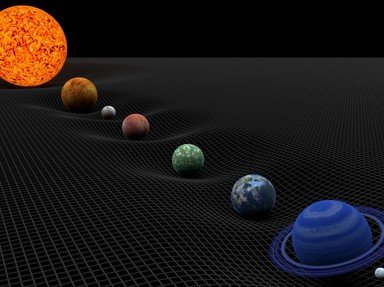Quiz Answer Key and Fun Facts
1. 4th century BCE: Aristotle believed that the elements of water and earth had a gravitational nature that led them downward, while fire and air were levitational, moving upward toward the "celestial sphere." The constant maneuvering of the elements of earth and water toward a center led Aristotle to believe in which of these ideas?
2. 3rd century BCE: Strato of Lampsacus rejected many of Aristotle's "natural" ideas about gravity, arguing towards a more mechanical explanation. His greatest contribution to gravitational theory was the idea that an object hitting the ground with greater force wasn't due to that object gaining more weight, but due to what?
3. 1st century BCE: In "De architectura," Roman engineer Vitruvius completed experiments on gravity using quicksilver (mercury). Due to its unique nature, he argued that gravity is NOT proportional to an object's ______, but affects all objects equally.
4. 900s CE: Ibn al-Haytham, a scion of the Islamic Golden Age, made many observations on gravity, including what idea concerning celestial bodies?
5. 1400s CE: Leonardo da Vinci performed a series of water vase experiments where he poured out drops of water at an even rate while moving the vase horizontally. What were da Vinci's experiments attempting to show gravity as a force of?
6. 1585 CE: A predecessor to Galileo's efforts, Flemish scientist Simon Stevin performed an experiment in which two lead balls with different masses were dropped from the Nieuwe Kerk church, with one lead ball being ten times heavier than the other. Crucial to the experiment, how could the lead balls' size and shape be described?
7. 1589-92 CE: While evidence that Galileo truly dropped spheres off the Tower of Pisa is scant, he still championed the idea that balls of different masses would nonetheless fall with the same acceleration. Within this idea, he also proposed that slight differences in speed between two falling bodies were the result of what?
8. 1609 CE: In his work "Astronomia nova", Johannes Kepler compared (but did not equate) the forces of gravity and magnetism through which of these aspects?
9. 1680s CE: Isaac Newton is foundational to our modern understanding of gravity. His theories, particularly those provided in his "Principia," were revolutionary and changed the way we looked at gravity and motion. Which of these was NOT one of the ideas Newton espoused in his lifetime?
10. 1905-15 CE: Albert Einstein's theories on relativity built upon and altered our understanding of Isaac Newton's ideas on gravity. While Newton generally believed that gravity was a force that acted instantaneously across space, what did Einstein believe?
Source: Author
trident
This quiz was reviewed by FunTrivia editor
rossian before going online.
Any errors found in FunTrivia content are routinely corrected through our feedback system.
